On View
‘We Were Seeing and Feeling Anxiety’: The Whitney Biennial Curators on How Artists’ Struggle With Debt and Real Estate Shaped the 2019 Show
Curators Rujeko Hockley and Jane Panetta talk about the cultural forces that influenced the show.
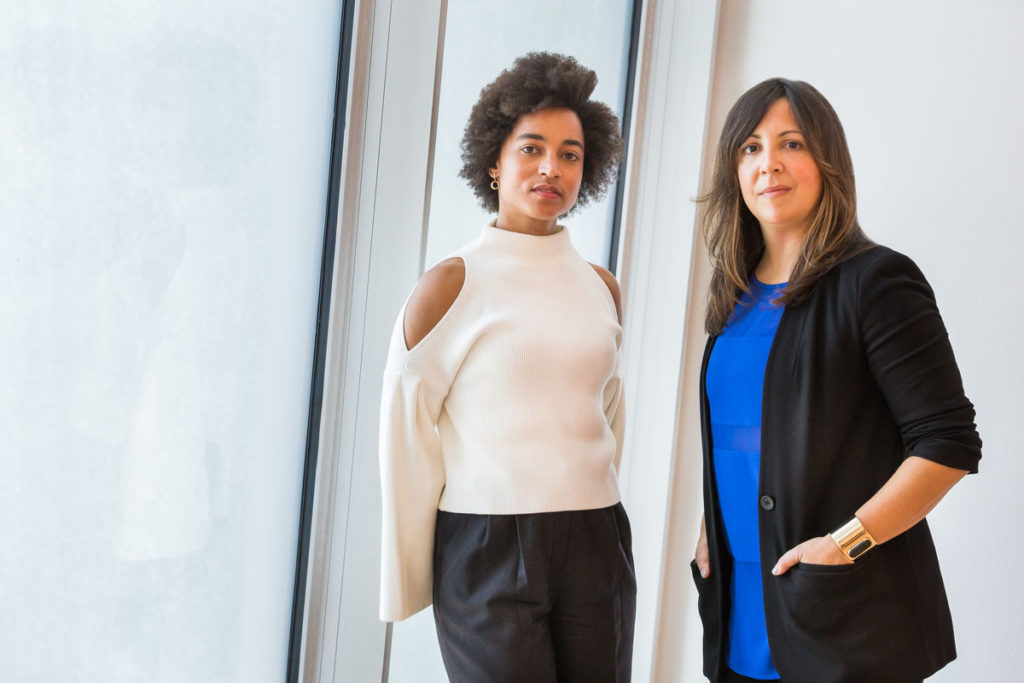
Curators Rujeko Hockley and Jane Panetta talk about the cultural forces that influenced the show.

Terence Trouillot

The Whitney Biennial—an exhibition that endeavors to put its finger on the pulse of contemporary American art-making today—is one of the more closely watched events in the art world. It always offers a selection of artists that set the tone for a new wave of artistic voices in America and beyond, and more often than not comes with a fair share of controversy as well.
This year’s Biennial is no different. The 79th edition presents a roster of 75 artists that veers disproportionately young, showcasing predominantly artists of color who have never exhibited at the museum before, including up-and-comers Alexandra Bell, Carolyn Lazard, Janiva Ellis, Meriem Bennani, and many others.
This selection is the work of biennial curators Jane Panetta and Rujeko Hockley, both of whom are members of the Whitney’s curatorial staff. It was not, however, a deliberate attempt to make the biennial a young and hip exhibition, they say, but rather the result of seeing a common thread among artists today: a sense of urgent financial and professional struggle due to college debt, real-estate development, and gentrification.
artnet News spoke to both curators, discussing this year’s biennial, the hardships faced by both artists and galleries today, and the importance of fostering a supportive community among art makers, curators, and art institutions.

Activists protesting against the continued presence of Warren Kanders on the board of the Whitney Museum. Photo by Erik McGregor/Pacific Press/LightRocket via Getty Images.
I want to get this question out of the way so we can focus on the nuts and bolts of the exhibition: Can you speak about the idea of controversy in regard to the Whitney Museum and its history? You could look back, from “Contemporary Black Artists in America” exhibition in 1971 to the controversy surrounding Dana Schutz’s painting of Emmett Till two years ago, to the current outrage over Warren B. Kanders, the vice chair of the museum’s board [and CEO of the weapons manufacturer Safariland], which led to artist Michael Rakowitz pulling out of the biennial.
How have these controversies influenced your decision making as curators? What conversations are you having with your colleagues and the artists involved in the show? What difficulties do they pose?
Rujeko Hockley: [Laughter] I mean, I don’t think it caused us to make different decisions, in terms of the most recent controversy. We had already invited all the artists and the Kanders controversy didn’t have any bearing on what we were doing.
Obviously we’re aware of the broader context of Whitney controversies, but I think each biennial is its own beast, and each moment is its own moment. So rather than thinking about the Whitney and its larger history, we’re really thinking about the artists we were meeting with and what they were interested in, and really trying to follow their lead.
Our colleagues have supported us very well at every turn before, during, and after this process. We don’t know what will happen once the show opens, obviously. And we also have that same support from all of the artists in the show. Jane and I have really endeavored to give that support back to the artists, knowing that they’re the ones who are going to be bearing the brunt of any decisions we make that in retrospect may be problematic or that people might find fault with. They’re the ones who are in the show, whose names are on the wall, and who may have to answer difficult questions from their own communities.
So we’ve really tried to be as transparent and supportive of their work as we can, which is what we’ve felt from our colleagues. We’re trying to pay that forward.
Jane Panetta: I think when you sign up to curate the biennial, there’s an understanding that this show has always been a space for important dialogue and that that has historically, in many instances, spurred debate and that debate and discourse are important. That is just by definition what this show has done and in many ways what it is designed to do. So I think we’re very comfortable with that idea from the outset and throughout. I think the artists understand that as well.
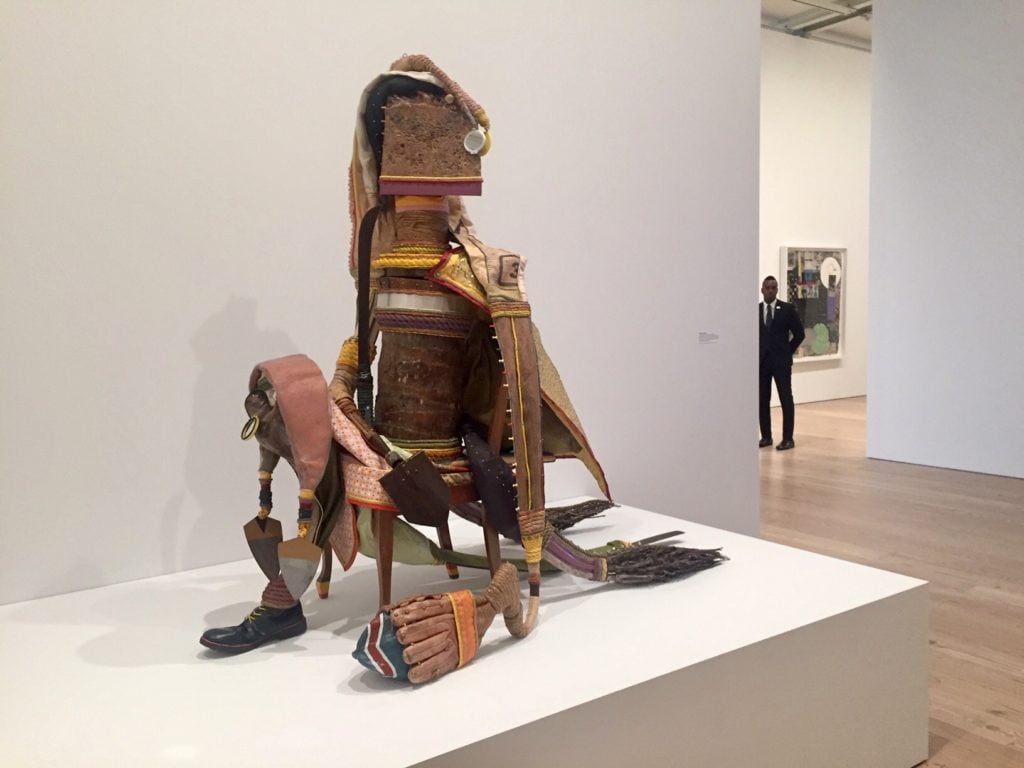
Daniel Lind-Ramos, 1797 Vencendor (1797: Victorious) (2017-18) at the 2019 Whitney Biennial. Courtesy of Ben Davis.
Can you talk about the research that went into this year’s biennial? Where did you travel the most? For example, there are a number of Puerto Rican artists in the show this year: Sofía Gallisá Muriente, Daniel Lind-Ramos, Las Nietas de Nonó, and Nibia Pastrana Santiago. Was there specific research done there?
JP: We did an extensive amount of traveling and I think we were on the road for about 14 weeks in the year and a half that we spent organizing the show. Pretty early on we made a list of key places that we knew we’d want to visit, including Puerto Rico. We looked at exhibitions that had taken place, and in a lot of instances we really looked to important nonprofit spaces in the places we wanted to visit. I’m thinking of Beta Local in San Juan, specifically. And then we visited those places when we were there, both to continue the conversation, but also as a way to get a better handle on the scene in these particular places, some of which we were not very familiar with in advance.
RH: Yeah that was important to us. We really tried as hard as we could to get outside of New York and LA, and to really spread our network as widely as we could. I think Puerto Rico was really on our minds just because, obviously and unfortunately, it’s been in the news a great deal due to Hurricane Maria. But also because this idea of history and how it influences the present was a theme that emerged very early on for us in terms of the work we were looking at.
The Whitney at large has been really trying to think through this question of American-ness. Where do Indigenous artists fall in that? Where do Puerto Rican artists fall in that? Where do American artists living outside of the United States or non-Americans living in the United States fit into that?
We went to Puerto Rico not really knowing what to expect and ended up having a very productive trip—really one our best ones, both in terms of the experience and also in terms of the artists who we met there, many of whom ended up in the biennial.
Where else did you travel?
RH: We went to Miami, New Orleans, Houston, Boston, Portland, Cleveland, Detroit, LA, San Francisco, and obviously New York. We also went to see the Berlin Biennial and met with American artists who live in Berlin. We traveled quite extensively, but obviously not exhaustively. There are always more places to go to, and I think you could do it for years and still find new people and new places.
![Installation view of works by Simone Leigh [foreground] and Janiva Ellis at the Whitney Biennial. Photo courtesy Ben Davis.](https://news.artnet.com/app/news-upload/2019/05/Simone-Leigh-installation-1024x683.jpg)
Installation view of works by Simone Leigh [foreground] and Janiva Ellis at the Whitney Biennial. Photo courtesy Ben Davis.
RH: I think [the selection] was really artist-driven and when looking at the totality we started to see certain things popping up. One of those things was absolutely the pressures on artists, which have always existed, but I think are definitely exacerbated and accelerated by gentrification, by new real-estate development, by the MFA debt that many artists go into. I also think this knock-on effect is felt not only among artists but also among young galleries, whereas in the past younger, smaller galleries would be incubators and spaces for artists to show work.
JP: What we saw in general was a lot of smaller and mid-sized galleries that have historically supported emerging artists struggle in the past years. Many of them have closed. It’s not a moment when a lot of new ones are emerging. It’s a tough moment vis-à-vis real estate, funding, and the market. That was something we saw consistently. We also saw, for a lot of younger artists, the price of studio space going up exorbitantly. We visited lots of artists in their homes, apartments, or in borrowed studios in very temporary spaces. So I think the combination of those things that we knew were happening here in New York—because we’re here and we’re regularly going to galleries here—we saw this elsewhere too, and a lot of talk about neighborhoods gentrifying, studio prices skyrocketing, and galleries struggling.
RH: Sometimes we were just seeing and feeling anxiety and concern about what is going to happen to these smaller and more informal spaces. And obviously the Whitney is an institution with a capital “I” and we cannot necessarily fill that void, but we really felt that the Biennial is an opportunity to give a platform to many different people. We were interested in new voices and expanding the platform of the Biennial as broadly as we could, while still being able to give the support that artists deserve.
What’s interesting about this year’s edition is that, although the 2017 biennial happened just after Trump’s inauguration, that whole show was planned before he was actually elected. That makes this year’s show the first real post-Trump biennial. I’m wondering if you both could speak about that in terms of all the work that’s being presented in the exhibition. In other words, do you see the work responding to the Trump presidency?
JP: A couple things. I think since Trump has been elected it has been a difficult time in this country. So there is definitely a very present social-political tenor to a lot of the work in the show. Work dealing with racial and gender issues and gentrification. So that is definitely there and it makes sense that these issues have become magnified since Trump’s inauguration.
That said, I think the work that’s in the show—to sort of generalize about what we’re seeing—did not feel exceptionally strident or solely about being angry or examples of agitprop. A lot of the work in the show has this difficult, timely content, but it feels more nuanced. And some of that may be the product the election, now well over two years ago at this point, but we’re still dealing with the reality of this administration. We’ve also adjusted to what I think felt like a really traumatic moment at the time of the inauguration. So it makes sense to me that the work now has that content. It’s almost looking ahead now to what our future can look like. What are the alternate ways of being in the world? It’s sort of accepting the reality and looking ahead.
RH: Yeah, there is a real note of thoughtfulness and even hopefulness in some cases as well. Trump does appear in some of the work, but I would say that it is certainly not an overarching theme in any way. We weren’t especially interested in that. It’s a show of this moment, but I wouldn’t say that we were overly thinking about him specifically.
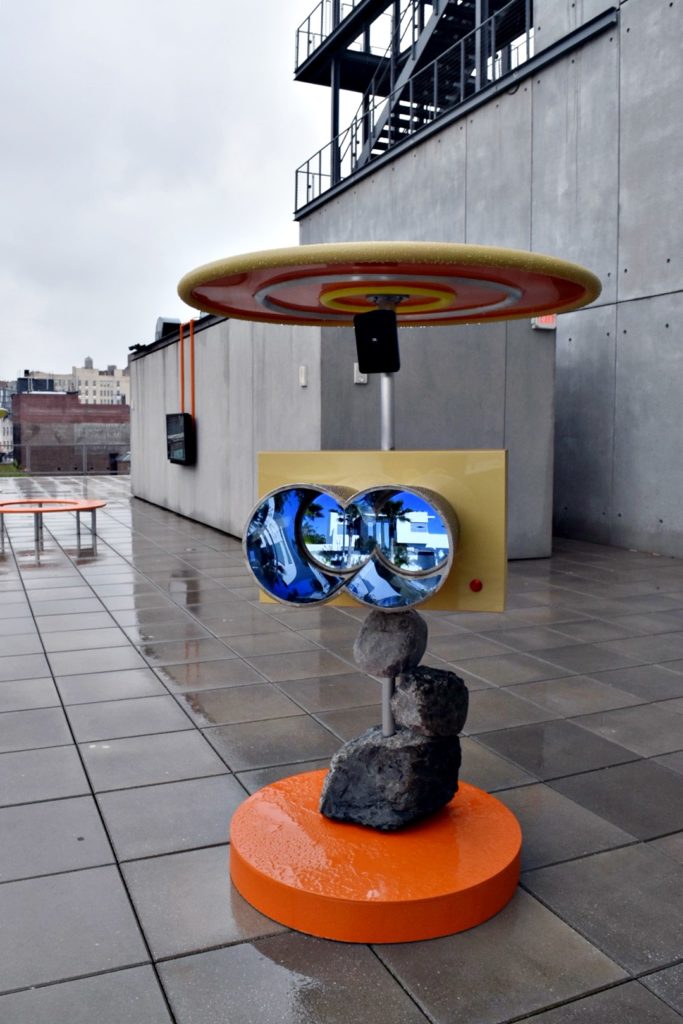
Meriem Bennani, detail of MISSION TEENS: French school in Morocco (2019) at the 2019 Whitney Biennial. Courtesy of Ben Davis.
I’d like to come back to this idea of “American-ness.” Can you speak to the idea of the Whitney Biennial as an American art exhibition and what that means to both of you, since a larger number of artists included were not born in the US or do not currently live in the US compared to previous biennials.
JP: I don’t know that it’s really that different from last time on that front. But I think in recent years the museum has been deeply invested in this idea of expanding the definition of who is an “American artist” and that for us meant looking at a lot of artists who live and work here, but who are maybe not born here or maybe don’t live here full time. And then similarly we visited a number of artists who are American but live outside the United States. This is not a totally new phenomenon either. The museum has plenty of works in our collection and they’ve shown things here before over the decades where artists are not born or exclusively living in the United States. There has been an increased interest, I would say institutionally, in bringing more voices and keeping that definition as open as possible. And we definitely followed suit in terms of the artists we visited and how we organized the biennial.
RH: Jane and I definitely took our cue in many ways from the ongoing work that the Whitney has been doing institutionally to think about this kind of question: “what is American and American art?” And throughout the Whitney’s history this has been answered differently at different times. Who qualifies as an American artist and how can you define American art? I don’t know that you can, and obviously every era answers that question differently, but the general trend has been toward a greater expansiveness to the answer of that question. So we have been thinking, as I said previously, a lot about Indigenous artists within the context of American art: Why haven’t they historically been included in institutions like the Whitney? How can we address that in our moment specifically? And thinking about questions around Latinx identities as well, or about the Americas more broadly in terms of North America, Central America, and South America.
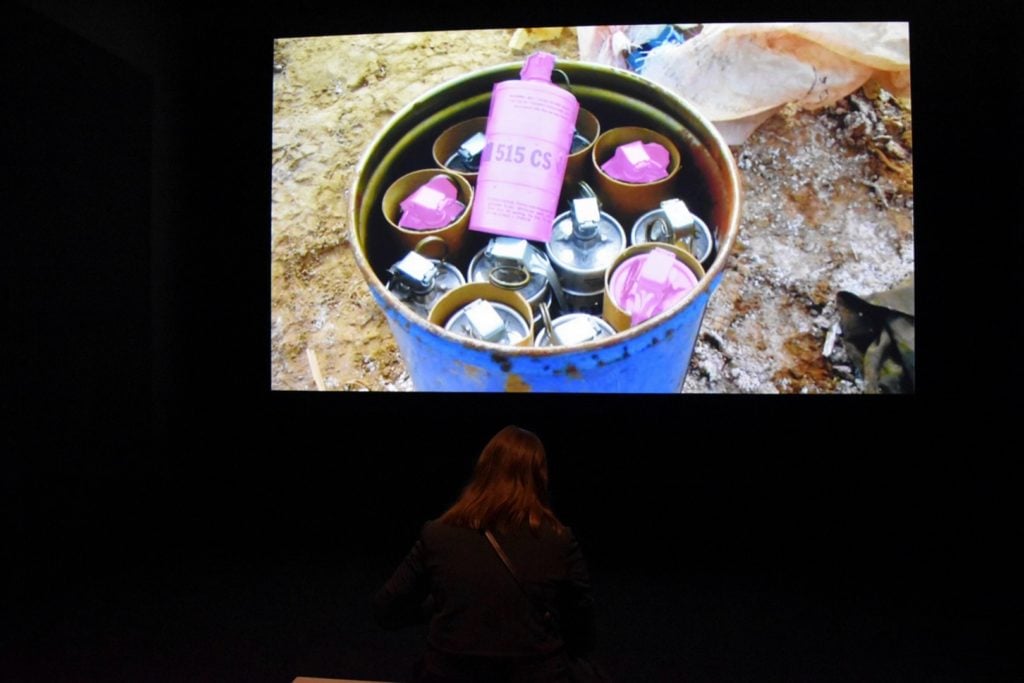
Forensic Architecture’s Triple Chaser video installed at the Whitney Biennial. Photo courtesy Ben Davis.
It’s interesting that there are five collectives participating in the biennial at the same time that documenta has chosen an artist collective to organize its next edition. Why are collectives flourishing in this moment? What do you find compelling about the collectives you’ve chosen for the biennial?
RH: I don’t know if I can speak to why collectives may or may not be flourishing in this moment. I don’t know if it’s necessarily different from past moments. I think again we were just really drawn to the work. I think the reason artists have often worked collaboratively, whether it’s through a formally rendered collective or just socially through informal networks, is to foster this idea of community. I can’t say that impulse is one that is new to this moment, but it certainly does feel very important right now.
JP: I can’t say that was a conscious decision on our part necessarily. We weren’t like, “Let’s make sure there’s a lot of collectives in the show.” That wasn’t something we were thinking about, but it makes sense along the lines of what I was saying before. With all the struggles that artists have to go through today, collectives are a way for artists to support one another. It’s a way to share the time and labor of making art. It’s not easy to dedicate time and resources to producing art, especially for artists that are more emerging. I think having the support of one or multiple other collaborators is important.
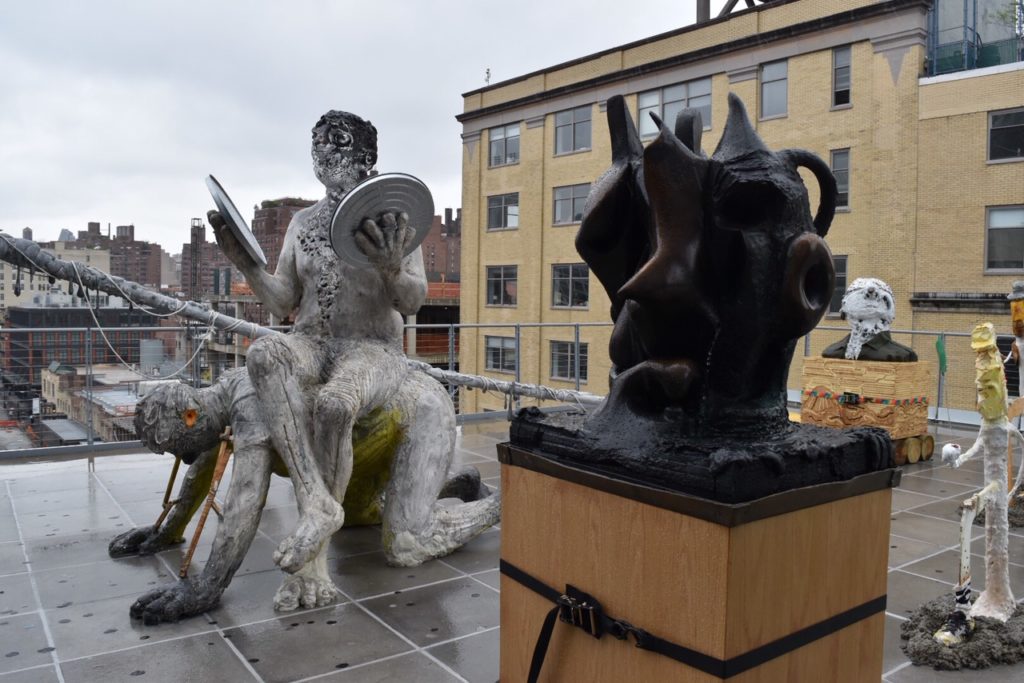
Detail of Nicole Eisenman’s sculptural tableau Procession (2019) on the museum terrace for the 2019 Whitney Biennial. Courtesy of Ben Davis.
What are some of the works that stand out the most for you in this exhibition, or are you particularly excited about presenting?
JP: Oh that’s a hard question. I’m super excited about all the work, truly. One general thing is that we have these amazing site-specific commissions for our terraces. Meriem Bennani is doing a sculptural video installation on the fifth floor terrace and Nicole Eisenman made this sculptural tableau for the sixth floor terrace. Using the terraces in that way with two sculptors, neither of whom have worked outdoors that much, felt very exciting to us.
RH: That’s like choosing between children. One of the big picture things that I think is exciting is the performance programming. Jane and I were really committed to including a robust performance program in this year’s biennial. That was really important to us. Similarly, for the film program we invited outside curators to contribute, so we have three people who not only curated a weekend of film programs, but also chose artists they wanted to invite. It was worthwhile to extend authorship in some ways to other people that we admire and to be able to open up the conversation in that way. It was another means of embracing this collective-working mode and thinking about community and how we can kind of cultivate knowledge in a horizontal and non-hierarchical way.
The other thing is that Jane and I both work at the Whitney, which is the first time in over a decade that the curatorial team has been totally internal. I had a baby in the middle of it—two-and-a-half months ago—and I’ve been really blessed by the people who work at the Whitney. Everyone has been incredible and so committed to this exhibition, and worked so diligently, so closely, and so respectfully with the artists. And of course Jane is the most incredible co-curator and collaborator. So yeah, I think that experience has really been a really wonderful one and continues to be… and we’re not done yet. [Laughter]